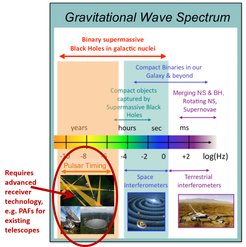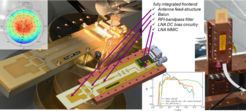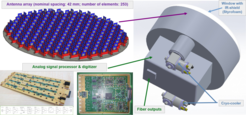
The CryoPAF Project
A Phased Array Feed overcoming most limitations of classical receivers.
The CryoPAF project was started as sub-project B2 of Low Frequency Gravitational Wave Astronomy and Gravitational Physics in Space; a collaborative project of CAS and MPG.
Technical Motivation

Phased Array Feed (PAF) systems can overcome most intrinsic limitations of classical receivers. Their narrow-spaced antennas “catch” nearly all photons arriving in a given area. In doing so, they can grant us access to the full field of view of a telescope and even expand it beyond the size applicable for standard focal plane arrays. The narrow antenna spacing creates the need for beam forming, an intense computational post processing of the data online. Beam forming allows us to correct for telescope aberrations and for free beam positioning (e.g. caused by overlapping beams) within their field of view. As this process captures all available information, beams can be formed even in a way that avoids human-made radio interference, originating e.g. from mobile phones or Wi-Fi. This can help to recover a number of frequency bands for scientific use, which would nowadays otherwise be completely blocked by technical applications.
One major challenge to making the PAF a reality is the need for hundreds of elements that fill the focal plane. Across the system, there must be a high level of integration in all areas without compromising on the sensitivity of individual elements. The development of new technologies is crucial to accomplishing this goal. For this endeavor, overall data rates are extremely high, in the order of TB/s, and must be processed online in real time. To keep costs within reason, a precise performance analysis becomes necessary that optimizes the performance/cost ratio.
Technical Solutions
The 250 elements of the CryoPAF focal plane array require a more manageable architecture of closely packaged cryogenic frontend modules. Specifically, ease of integration into the focal plane array and a module design that simplifies assembly. To facilitate this, we have developed a novel baseline design featuring a fully integrated cryogenic frontend. This includes the feed antenna structure, an RF-circuitry with e.g. RFI filter and/or Balun, and the first stage LNA including a bias network. This single PCB-based frontend can be produced as a standard PCB with the help of a standard automated pick and place assembly.

A first prototype is under test since early 2025 and will form a first warm PAF demonstrator for the Effelsberg 4m dish in summer 2025.
The main antenna array is formed from 253 DRA antennas, implemented into the integrated cryogenic frontend. It is arranged to provide two orthogonal linear polarizations. A styrofoam-based IR filter covers the antenna array and additionally provides mechanical support for a thin vacuum window made out of Mylar. The cryogenic frontend is cooled to < 20K (< -253°C) by two commercial cryo-coolers. The backside of the cryostat houses a big box, which is connected to the internal vacuum and houses the analog signal processors and the digitizers. This more direct connection circumvents the need for 253 RF-vacuum feed-throughs. The box provides cooling via heat-pipes to the electronics, drawing from a water-cooling system outside the vacuum area.

A highly integrated 2x 4-channel analog signal processor with approximately 90 dB of gain, an anti-aliasing filter, a gain equalizer, and a remotely adjustable output power level is available and nearly ready for mass production. Our design includes a housing that provides excellent RF shielding to avoid any self-excitation and self-induced RFI, e.g. emitted by the receiver’s digital systems. The analog signal processor directly connects to the 8-channel digitizer board, which provides power and remote connection for the signal chains. Since both the analog signal processor and the digitizer can be operated from within the vacuum, the cryostat output is already fully digital.
Digital outputs from the digitizers are routed to a so-called channelizer farm outside the primary focus cabin. The channelizers are an FPGA farm of 32 FPGAS, providing channelization via a poly-phase filter bank and transferring the data to Ethernet-based data streams. All of these data streams are in turn fed into our in-house high-throughput, flexible compute infrastructure EDGAR, which acts as a multi-purpose online backend for the system. EDGAR is capable of providing the beam forming, and the first stage data processing to scientific data products such as VLBI-output, time domain data, or full-Stokes spectroscopic data (additional information is available at the EDGAR project site).














